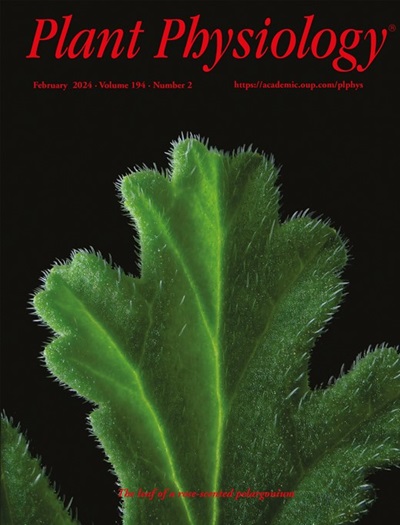The putative endo-1,4-β-D-glucanase GLU3 regulates cellulose biosynthesis in barley roots.
IF 6.5
1区 生物学
Q1 PLANT SCIENCES
引用次数: 0
Abstract
The plant cell wall is a crucial structure that ensures plant cell integrity and facilitates environmental adaptation. Cellulose is the primary component of the plant cell wall. Its biosynthesis is orchestrated through the plasma membrane-localized multiprotein cellulose synthase complex, which includes a membrane-anchored endo-1,4-ß-glucanase. Here, we identified a barley (Hordeum vulgare) mutant with short roots resulting from repressed cell division and elongation, which we designated hordeum vulgare endo-β-1,4-D-glucanase 3-1 (hvglu3-1). HvGLU3 encodes a putative membrane-anchored endo-1,4-ß-glucanase that is highly conserved across plant species. The hvglu3-1 mutant exhibited a 60% reduction in cellulose content, accompanied by changes in hemicellulose and suberin levels and an altered lignin structure in the roots. Subcellular localization analyses and bimolecular fluorescence complementation assays suggested a direct interaction between HvGLU3 and primary cellulose synthases. We investigated the reprogramming of the tissue-specific transcriptome in hvglu3-1 root tips using a combination of laser capture microdissection (LCM) and RNA sequencing. This approach revealed that 74% of all genes that are actively expressed in the elongation zone are influenced by root cellulose biosynthesis. Gene co-expression analyses highlighted the essential role of cellulose biosynthesis in diverse biological processes, including cell wall organization, phytohormone signaling, and stress responses, to regulate root tissue development. Overall, our study demonstrates the partially conserved role of HvGLU3 in controlling cellulose biosynthesis in roots and provides valuable transcriptomic resources for future studies.假定的内切-1,4-β- d -葡聚糖酶GLU3调节大麦根中纤维素的生物合成。
植物细胞壁是保证植物细胞完整性和促进环境适应的重要结构。纤维素是植物细胞壁的主要成分。它的生物合成是通过质膜定位的多蛋白纤维素合成酶复合物进行的,其中包括一个膜锚定的内-1,4-ß-葡聚糖酶。在这里,我们发现了一个大麦(Hordeum vulgare)突变体,由于细胞分裂和伸长受到抑制而导致根短,我们将其命名为Hordeum vulgare内do-β-1,4- d -葡聚糖酶3-1 (hvglu3-1)。HvGLU3编码一种假定的膜锚定的内-1,4-ß-葡聚糖酶,该酶在植物物种中高度保守。hvglu3-1突变体纤维素含量降低60%,并伴有半纤维素和亚木质素水平的变化,根系木质素结构发生改变。亚细胞定位分析和双分子荧光互补分析表明,HvGLU3与初级纤维素合成酶之间存在直接相互作用。我们使用激光捕获显微解剖(LCM)和RNA测序相结合的方法研究了hvglu3-1根尖组织特异性转录组的重编程。该方法表明,74%在伸长区活跃表达的基因受到根纤维素生物合成的影响。基因共表达分析强调了纤维素生物合成在多种生物过程中的重要作用,包括细胞壁组织、植物激素信号传导和胁迫反应,以调节根组织发育。总的来说,我们的研究证明了HvGLU3在控制根中纤维素生物合成中的部分保守作用,为未来的研究提供了有价值的转录组学资源。
本文章由计算机程序翻译,如有差异,请以英文原文为准。
求助全文
约1分钟内获得全文
求助全文
来源期刊

Plant Physiology
生物-植物科学
CiteScore
12.20
自引率
5.40%
发文量
535
审稿时长
2.3 months
期刊介绍:
Plant Physiology® is a distinguished and highly respected journal with a rich history dating back to its establishment in 1926. It stands as a leading international publication in the field of plant biology, covering a comprehensive range of topics from the molecular and structural aspects of plant life to systems biology and ecophysiology. Recognized as the most highly cited journal in plant sciences, Plant Physiology® is a testament to its commitment to excellence and the dissemination of groundbreaking research.
As the official publication of the American Society of Plant Biologists, Plant Physiology® upholds rigorous peer-review standards, ensuring that the scientific community receives the highest quality research. The journal releases 12 issues annually, providing a steady stream of new findings and insights to its readership.
 求助内容:
求助内容: 应助结果提醒方式:
应助结果提醒方式:


